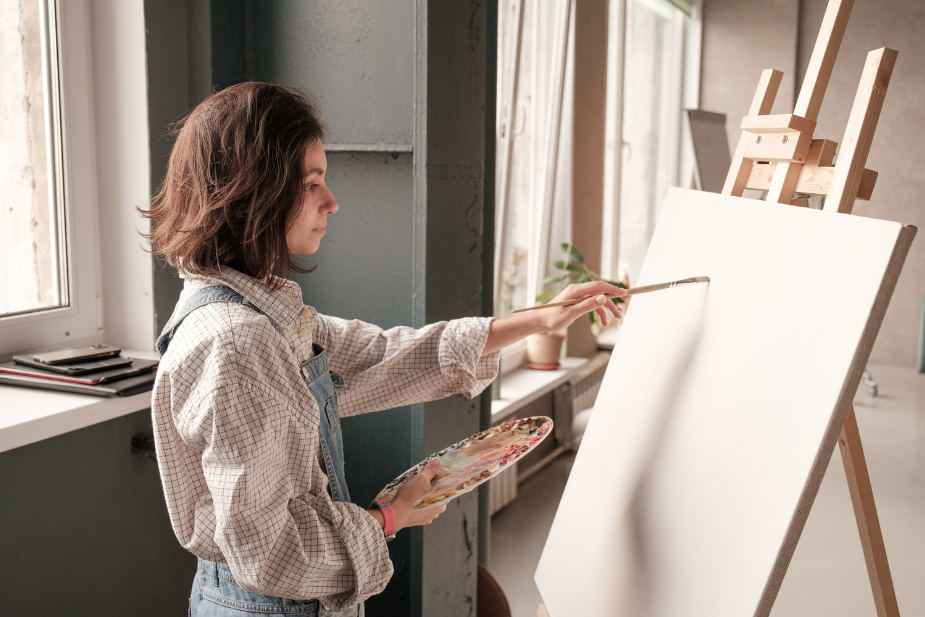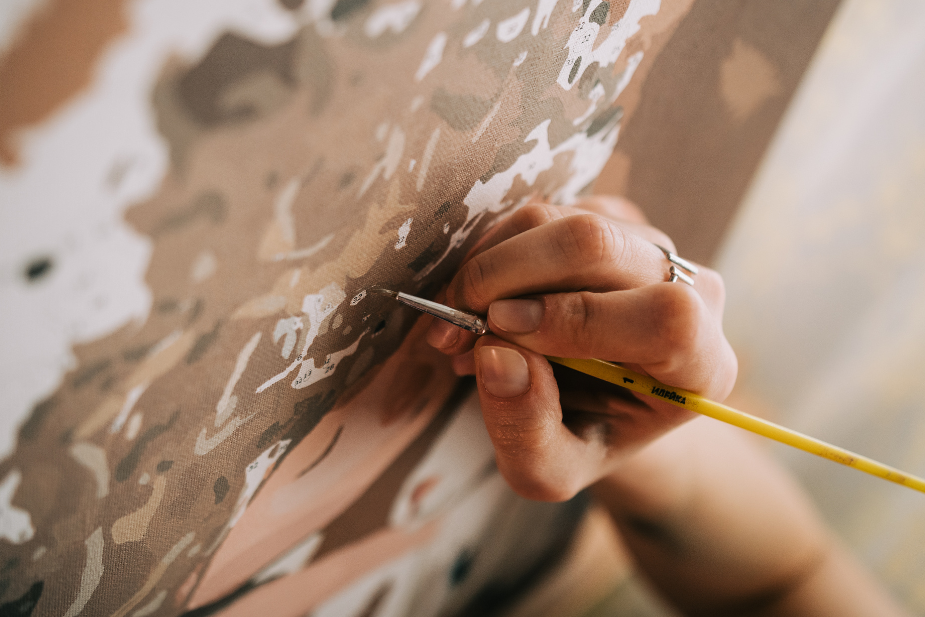
ACRYLIC PAINTING FOR BEGINNERS - Learn to paint with acrylics - step-by-step guide
Whether you're a beginner or looking to hone your skills, this guide is your guide to mastering the art of acrylic painting.
In this step-by-step guide, we'll explore the fundamentals of acrylic painting, from choosing the right materials to techniques that will bring your creations to life.
Acrylic paint is known for its versatility and ability to create both vibrant and durable colors, making it a popular choice for artists of all levels. So grab your brushes and prepare to dive into a world where color and creativity meet.
Let's take a closer look at the key steps and materials needed to get started with acrylic painting.
Before you get started
Before you start your acrylic painting project, it's important to have the right materials ready.
Acrylic paint and quality
Choose between studio and artist quality.
Studio quality often come in a more affordable price range and have a lower concentration of pigments. They have more fillers and can be less vibrant in color. System 3 would be a great choice for a good studio grade.
Artist grade has a higher pigment concentration, fewer fillers and provides more vibrant and durable colors. Golden, Schmincke, Sennelier and Vallejo are typically considered artist grade, which can be seen in their high quality and pigmentation.
See our full range of acrylic paints.
Brushes
The choice of brushes is crucial when painting with acrylics. To achieve different effects, a combination of long, short and the shape of the brush is necessary to keep in mind.
The long brushes are ideal for creating loose and broad strokes, especially on larger canvases. They provide excellent control and precision, which is important for an even application of paint.
Short brushes are best used for detailed and precise work where fine motor skills and control are needed.
Round acrylic brushes have a round and pointed shape, making them ideal for detailed work and fine lines. Their pointed shape allows you to paint with great precision, which is perfect for adding small details and fine nuances to a painting.
Flat brushes have a wide and flat shape, which makes them suitable for covering larger areas with paint. They are perfect for making broad strokes and filling larger areas quickly and efficiently.
See our selection of brushes for acrylic paint.
Painting palette
A painting palette is an essential tool for any acrylic painter. A palette with a non-sticky surface is ideal for mixing colors as it allows you to easily blend and experiment with different shades. A wet palette is particularly useful when working with acrylic paints as it helps keep colors fresh and moist for longer. This prevents the paint from drying out too quickly and gives you more time to work with your color mixtures.
Preparing the workspace
Preparing your workspace is essential for a successful experience.
Make sure the area has ample space and is well lit, which will make it easier to see details and colors correctly.
When choosing your painting surface, consider whether it should be acrylic paper or a canvas. Acrylic paper is a good choice for those who want a lightweight and affordable solution, while canvases offer a more traditional and robust painting surface.
Whatever you choose, it's important to pre-treat the surface with Gesso to ensure better color adhesion and a smoother painting experience.
See our selection of acrylic paper and canvases.
Get to grips with the basic techniques
While exploring the world of acrylic painting, it's important to know some basic techniques that can enhance your artistic skills. These different techniques include, for example
-
Smooth strokes to create even, unbroken surfaces
-
Drybrush techniques that add texture and depth to your painting.
-
Layered painting, which involves applying the paint as several thin layers of paint on top of each other.
-
Etc.
For a more detailed review of these and other techniques, we recommend you read our in-depth guide Painting techniques with acrylic paint. This guide will help you develop your skills further, whether you are a beginner or a more experienced artist.
Color mixing - How do you mix colors?
Understanding and applying colors is essential in acrylic painting. Here's a step-by-step guide to mixing colors:
-
Know the primary colors: Red, blue and yellow. These cannot be created by mixing other colors and form the basis for all other colors.
-
Create secondary colors: Mix two primary colors. Blue + yellow = green; red + yellow = orange; blue + red = purple.
-
Develop tertiary colors: Mix a primary color with a secondary color to create shades like teal or red-orange.
-
Start with small amountsWhen mixing colors, start with a small amount and adjust gradually.
-
Add black or white: For darker shades, add a bit of black or a complementary color. For lighter tones, use white or a lighter version of the primary color.
-
Pay attention to the drying process: Acrylic paint dries darker than it looks when wet.
-
Experiment and practice: Color mixing is an art, and practice will improve your understanding and technique when painting acrylics. Try different combinations to achieve the desired shade.
Correct mistakes in your acrylic painting
When painting with acrylics, you will inevitably encounter small "mishaps", but fear not - most mistakes can be corrected! Here are some steps to correct common mistakes:
-
Let the mistake dry: Trying to fix a mistake while the paint is wet will often only make the situation worse. Instead, let the mistake dry completely.
-
Apply white paint: If the mistake is dark and you need to paint over it with a lighter color, start by covering the area with white paint. This step is important because it helps neutralize the dark color so it doesn't shine through the new paint.
-
Paint over the defect: Once the white paint is dry, you can paint over the area with the desired color. This step may require several layers, especially if the original flaw was very dark or vibrant.
-
Patience and layering technique: The quick-drying nature of acrylic paint can be an advantage here. If the first attempt at correcting the mistake isn't completely opaque, wait for it to dry and apply a second coat.
-
Embrace the mistakes: Remember that mistakes are part of the learning process. Sometimes a mistake can lead to an unexpected but beautiful result. Be open to experimenting and learn from your mistakes.
These steps are relatively simple and can be applied to most mistakes in acrylic painting. The most important thing is to stay calm and remember that acrylic paint is a very forgiving medium. Every mistake is an opportunity to learn and improve your skills.
Experiment and enjoy the process
Now it's time to get started.
Experiment and enjoy the process. The creative part is what makes painting with acrylics so unique and rewarding. There are no set rules, giving you the freedom to experiment with different techniques and mediums. Try mixing colors in new ways, using different brush strokes, or integrating textures into your work. Explore the use of mixed media by combining acrylic paint with other materials like collage or pastel. Remember that each brushstroke is a step on a learning journey where mistakes are part of the learning process. Enjoy every moment of your artistic journey and let your creativity lead you to new forms of expression.
Cleaning up
Once you've completed your painting, it's essential to clean your brushes thoroughly with soap and water. This prevents acrylic paint from drying and damaging the brushes and ensures they remain in good condition for future use. Also, remember to store your painting tools properly to prolong their lifespan.
Have a great time!



